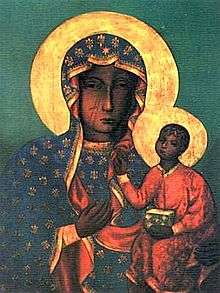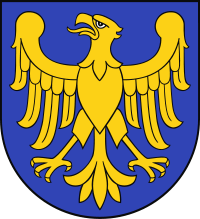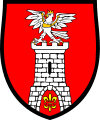Częstochowa
Częstochowa (/ˌtʃɛnstəˈkoʊvə/ CHEN-stə-KOH-və,[2][3] Polish: [tʂɛ̃stɔˈxɔva] (![]()
Częstochowa | |
|---|---|
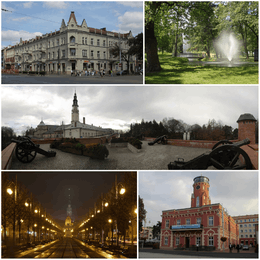 Left to right: eclectic tenement house, fountain at Stanisław Staszic Park, view of May Third Park and Jasna Góra Monastery, view of Holy Virgin Mary Avenue, Częstochowa City Hall | |
 Flag  Coat of arms | |
| Motto(s): Jasne, że Częstochowa (Of course Częstochowa) | |
 Częstochowa  Częstochowa | |
| Coordinates: 50°48′N 19°7′E | |
| Country | |
| Voivodeship | |
| County | city county |
| Established | 11th century |
| Town rights | 1356 |
| Government | |
| • Mayor | Krzysztof Matyjaszczyk (SLD) |
| Area | |
| • City | 160 km2 (60 sq mi) |
| Population (31 December 2019) | |
| • City | 220,433 |
| • Density | 1,400/km2 (4,000/sq mi) |
| • Metro | 400,000 |
| Time zone | UTC+1 (CET) |
| • Summer (DST) | UTC+2 (CEST) |
| Postal code | 42-200 to 42-229, 42-263, 42-271, 42-280, 42-294 |
| Area code(s) | +48 34 |
| Car plates | SC |
| Climate | Cfb |
| Website | http://www.czestochowa.pl/ |
The city is known for the famous Pauline monastery of Jasna Góra, which is the home of the Black Madonna painting (Polish: Jasnogórski Cudowny obraz Najświętszej Maryi Panny Niepokalanie Poczętej), a shrine to the Virgin Mary. Every year, millions of pilgrims from all over the world come to Częstochowa to see it. The city also was home to the Frankism movement in the late 18th and the 19th century.
The city has undertaken excavation of an ancient site of Lusatian culture, and has a museum devoted to this. The ruins of a medieval castle stand in Olsztyn, approximately 25 kilometres (16 miles) from the city centre (see also Trail of the Eagles' Nests).[4]
City name
The name of Częstochowa means Częstoch's place and comes from a personal name of Częstoch, mentioned in the medieval documents also as Częstobor and Częstomir.[5] Variations of the name include Czanstochowa used in 1220, and Częstochow used in 1382 and 1558. A part of today's city called Częstochówka was a separate municipality mentioned in the 14th century as the Old Częstochowa (Antiquo Czanstochowa, 1382) and Częstochówka in 1470–80.[6] The city was also known in German as Tschenstochau and in Russian as Ченстохов (Chenstokhov).
History
According to archaeological findings, the first Slavic settlement in the location of Częstochowa was established in the late 11th century. It was first mentioned in historical documents from 1220, when Bishop of Kraków Iwo Odrowąż made a list of properties of the Mstów monastery. Two villages, Częstochowa and Częstochówka were mentioned in the document. Both of them belonged to the basic territorial unit of Slavic tribes (opole), with its capital at Mstów. Częstochówka was located on a hill, where the Jasna Góra Monastery was later built.
In the late 13th century Częstochowa became the seat of a Roman Catholic parish church, which was under the Lelów deanery. The village was located in the northwestern corner of Kraków Land, Lesser Poland, near the Royal Castle at Olsztyn. Częstochowa developed along a busy merchant road from Lesser Poland to Greater Poland. The village was ruled by a starosta, who stayed at the Olsztyn Castle.
It is not known when Częstochowa was granted town charter, as no documents have been preserved. It happened sometime between 1356–1377. In 1502, King Alexander Jagiellon granted a new charter, based on Magdeburg rights to Częstochowa. In 1382 the Paulist monastery of Jasna Góra was founded by Vladislaus II of Opole – the Polish Piast prince of Upper Silesia. Two years later the monastery received its now-famous Black Madonna icon of the Virgin Mary; in subsequent years became a centre of pilgrimage, contributing to the growth of the adjacent town.[4]
Częstochowa prospered in the late 15th and early 16th centuries, due to efforts of Sigismund I the Old, the future king of Polish–Lithuanian Commonwealth. At that time, Sigismund ruled the Duchy of Głogów, and frequently visited Częstochowa on his way to the Duchies of Silesia (1498, 1502, 1502, 1503, 1505, 1505, 1506). In 1504, Częstochowa was granted the right to collect tolls on the Warta (Latin: Varta) river bridge. In 1508, Częstochowa was allowed to organise one fair a year; in 1564, the number of fairs was increased to three annually, and in 1639 to six. In the year 1631, Częstochowa had 399 houses, but at the same time, several residents died in a plague, after which 78 houses were abandoned.[4]
In the first half of the 17th century, kings of the House of Vasa turned the Jasna Góra Monastery into a modern Dutch-style fortress. During the Swedish invasion of Poland in 1655, the monastery was one of the pockets of Polish resistance against the Swedish armies (for more information, see Siege of Jasna Góra). The town of Częstochowa was almost completely destroyed by Swedish soldiers. It has been estimated that the town lost 50% of the population, and 60% of houses. But the town suffered less severe destruction than such area towns as Przyrów, Olsztyn and Mstów. It took several years for Częstochowa to recover from extensive losses. As late as in the 1680s there still were ruined houses in the town.
At the same time, the Jasna Góra Monastery prospered. On February 27, 1670, the wedding of the king Michał Korybut Wiśniowiecki to princess Eleanor of Austria took place here. In 1682 the celebration of the 300th anniversary of the Black Madonna of Częstochowa brought thousands of pilgrims from both Polish–Lithuanian Commonwealth and Silesia. The Jewish community in Częstochowa developed by about 1700.[4]

During the Great Northern War, Częstochowa was captured by the Swedish army on August 11, 1702. In February 1703 Swedes besieged the monastery, but failed to seize it. In April 1705 the Swedes returned, and appeared at the monastery again in September 1709. Unable to capture the fortified stronghold, they looted villages in the area, set Częstochowa on fire, and left towards Wieluń. At that time, a village of Częstochówk also existed next to Częstochowa. The village belonged to the monastery and quickly developed. In 1717 it was granted town charter, and its name was changed into Nowa Częstochowa (New Częstochowa). The town was completely destroyed during the Bar Confederation. On February 8, 1769, the monastery was seized by rebels of the Bar Confederation, commanded by Kazimierz Pułaski. Soon the stronghold was besieged by Russians under German-born General Johann von Drewitz. The Russians gave up on January 15, 1771.[4]

In 1789, the population of Częstochowa (also called Stara Częstochowa, Old Częstochowa) was app. 1,600, which was less than in the 15th century. After the Sejm passed the Constitution of May 3, 1791, local Sejmiks were obliged to legitimize it. On February 14–15, 1792, a sejmik of the szlachta of northern part of Kraków Voivodeship (counties of Lelów and Książ Wielki) took place in Częstochowa. Traditionally, local sejmiks were organized in Żarnowiec; the fact that it was moved to Częstochowa confirms the growing importance of the town.
In 1760, Jacob Frank, the leader of a Jewish sect mixing Kabbalah, Catholicism and Islam, was imprisoned for heresy in the monastery by the church. His followers settled near him, later establishing a cult of his daughter Eve Frank. In August 1772, Frank was released by the Russian general Aleksandr Bibikov, who had occupied the city. Frank had promised the Russians that he would convince Jews to convert to Orthodox Christianity.[4]
Partitions of Poland
During the Partitions of Poland, Częstochowa was seized by the Kingdom of Prussia in 1793, and incorporated into the province of South Prussia, Department of Kalisz (Kalisch). The Old Częstochowa became the seat of a county (see Districts of Prussia). During the Napoleonic Wars, in 1807 Częstochowa became part of the Duchy of Warsaw. In 1815 it came under Russian-controlled Congress Poland, in which it remained until World War One. Old Częstochowa remained the seat of a county in 1807–1830. In 1809, the monastery was unsuccessfully besieged by Austrians (see Polish–Austrian War). On April 2, 1813, Jasna Góra was seized by the Russians (see War of the Sixth Coalition), after a two-week siege.[4]
In 1821, the government of Congress Poland carried out a census, according to which the population of New Częstochowa was 1,036, while the population of Old Częstochowa was 2,758. Furthermore, almost four hundred people lived in several settlements in the area (Zawodzie, Stradom, Kucelin). The idea of a merger of both towns was first brought up in 1815. In 1819, military architect Jan Bernhard planned and started the construction of Aleja Najświętszej Panny Marii—the Holy Virgin Mary Avenue, which is the main arterial road of the modern city. It connected Old Częstochowa with New Częstochowa.
Finally, the two towns were officially merged on August 19, 1826. The new city quickly emerged as the fourth-largest urban centre of Congress Poland; surpassed only by the cities of Warsaw, Lublin, and Kalisz. On September 8, 1862, a patriotic rally took place in the city, in front of St. Sigismund church. As a reprisal, Russian military authorities destroyed app. 65% of Częstochowa's Old Town, and introduced martial law . During the January Uprising, several skirmishes took place in the area of Częstochowa, with the last one taking place on July 4, 1864 near Chorzenice.
In 1846 the Warsaw-Vienna Railway line was opened, linking the city with the rest of Europe. After 1870 iron ore started to be developed in the area, which gave a boost to the local industry. Among the most notable investments of the epoch was the Huta Częstochowa steel mill built by Bernard Hantke, as well as several textile mills and paper factories.
Up to the Second World War, like many other cities in Europe, Częstochowa had a significant Jewish population: according to Russian census of 1897, out of the total population of 45,130, Jews constituted 12,000 (so around 26% percent).[7] An anti-Semitic pogrom occurred in 1902, Częstochowa pogrom (1902).[8] A mob attacked the Jewish shops, killing fourteen Jews and one gendarme.[9]
Częstochowa entered the 20th century as one of the leading industrial centres of Russian Poland (together with Warsaw, Łódź, and Zagłębie Dąbrowskie). The city was conveniently located on the Warta and other smaller rivers (Kucelinka, Stradomka, Konopka). Real estate and land prices were low, compared to Łódź. The monastery attracted numerous pilgrims, who also were customers of local businesses. In 1904, Częstochowa had 678 smaller workshops, which employed 2,000 workers. In 1902, rail connection to the Prussian border crossing at Herby Stare was opened, and in 1911, the line to Kielce was completed. The Revolution in the Kingdom of Poland (1905–1907) began in Częstochowa as early as May 1904, when first patriotic rallies took place. On December 25, 1904, a man named Wincenty Makowski tried to blow up a monument of Tsar Alexander II, which stood in front of the monastery. In February 1905, a general strike action was declared in the city, with workers demanding pay rises. In June 1905 street clashes took place in Częstochowa, in which 20 people were killed by Russian forces. Further protests took place in 1909 and 1912.[4]
World War One
In early August 1914, Częstochowa was abandoned by the Imperial Russian Army, and the first units of the German Army entered the city on August 3. Four days later drunken German soldiers shot at each other; an unknown number died. Residents of the city were accused of killing Germans, and as a punishment, a number of civilians were executed. During the German occupation (1914–1918), Częstochowa was cut off from its traditional Russian markets, which resulted in widespread poverty and unemployment. Furthermore, German authorities closed down several factories, urging unemployed workers to migrate to Upper Silesia, where they replaced men drafted into the army. Altogether, some 20,000 left for Upper Silesia and other provinces of the German Empire. On February 2, 1915, Częstochowa was visited by Charles I of Austria. Four days later Emperor Wilhelm II came to the city, and on May 17, 1915, Częstochowa hosted King of Saxony Frederick Augustus III.
Unlike the city of Częstochowa, since April 26, 1915, the Jasna Góra Monastery had been under the control and protection of Austria-Hungary, after the personal intervention of Emperor Franz Joseph I, who was a pious Roman Catholic. The monastery was manned by soldiers under Austrian Army Captain Josef Klettinger and remained under Austrian control until November 4, 1918. In October 1917, the City Council of Częstochowa demanded permission to destroy the monument to Tsar Alexander II, to which General Governor of Warsaw Hans Hartwig von Beseler agreed. Polish authorities established control over the entire city on November 11, 1918.
Second Polish Republic
On November 12, 1918, three companies of the freshly created Polish Army marched along the Holy Virgin Mary Avenue. In 1919–1921, Częstochowa was one of the centres of support of Silesian Poles fighting in the Silesian Uprisings. On December 4, 1920, Symon Petliura arrived, together with app. 2,000 Ukrainian soldiers. Their arrival spurred widespread protests, as the city already had a desperate food situation and was obliged to house and feed the Ukrainians.
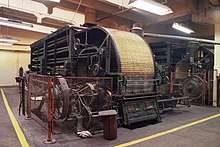
In the Second Polish Republic, Częstochowa belonged to Kielce Voivodeship (Kieleckie), where since 1928 it constituted City County of Częstochowa. In the 1920s, the local industry still suffered from World War One losses, and having been cut off from Russian markets. Unemployment remained high, and thousands of workers left for France in search of jobs. The Great Depression was particularly difficult, resulting in strikes and workers' street clashes with the police.
In 1925, the Roman Catholic Archdiocese of Częstochowa was created. The city grew in size, when between 1928 and 1934, several local settlements and villages were annexed. In 1939, the population of Częstochowa was 138,000, which made it the 8th-largest city of Poland. In 1938, the Polish government announced plans to liquidate Kielce Voivodeship, and create Sandomierz Voivodeship (Sandomierskie), based on Central Industrial Area. According to these plans, Częstochowa was to be transferred either to Łódź Voivodeship (Łódzkie), or Silesian Voivodeship (Ślaskie), together with Zagłębie Dąbrowskie.
World War Two
In the Polish Defensive War of 1939, Częstochowa was defended by the 7th Infantry Division, part of northern wing of Kraków Army. After the Battle of Mokra and other battles, Polish forces withdrew, and the Wehrmacht entered the city on Sunday, September 3, 1939. Częstochowa was renamed by the Germans as Tschenstochau, and incorporated into the General Government. Monday, September 4, 1939, became known as Bloody Monday or also Częstochowa massacre.[10] The Germans killed 227 people (205 ethnic Poles and 22 Jews) (some estimates of victims put the number at more than 1,000; 990 ethnic Poles and 110 Jews).
From the beginning of the occupation, the Germans initiated a plan of cultural and physical extermination of the Polish nation. Częstochowa was a city-county (Stadkreis Tschenstochau), part of the Radom District of the General Government. The city was located near the border with Upper Silesia Province, and in its area operated units of the Home Army and National Armed Forces (NSZ). On April 20, 1943, a NZS unit attacked the local office of the Bank Emisyjny w Polsce. After the collapse of the Warsaw Uprising, Częstochowa briefly was the capital of the Polish Underground State. In the autumn 1944, Germans fortified the city, preparing for a lengthy defence. On January 16, 1945, however, the Wehrmacht retreated after just one day of fighting.
On April 9, 1941, the Nazis had created a ghetto for Jews in the city. [11] During World War II approximately 45,000 of Częstochowa's Jews, almost the entire Jewish community living here, were killed by the Germans. Life in Nazi-occupied Częstochowa is depicted in the Pulitzer Prize-winning graphic novel Maus, by Art Spiegelman, the son of a Jewish Częstochowa resident. Before the Holocaust, Częstochowa was considered a great Jewish centre in Poland. By the end of WWII, nearly all Jews had been killed or deported to death camps to be killed, making Częstochowa what the Nazis called Judenfrei.
Modern day
Due to the communist idea of fast industrialisation, the inefficient steel mill was significantly expanded and named after Bolesław Bierut. This, combined with the growing tourist movement, led to yet another period of fast city growth, concluded in 1975 with the creation of a separate Częstochowa Voivodeship (Częstochowskie). In the immediate post-war period, Częstochowa belonged to Kielce Voivodeship (1945–1950), and then the city was transferred to Katowice Voivodeship (Katowickie). In the People's Republic of Poland, Częstochowa emerged not only as an industrial, but also academic centre of the region. The city expanded, with the first tram lines opened in 1959. On January 1, 1977, several villages and settlements were annexed by Częstochowa. As a result, the area of the city expanded from 90 to 160 square kilometres (35 to 62 sq mi).
In modern times, Pope John Paul II, a native son of Poland, prayed before the Black Madonna during his historic visit in 1979, several months after his election to the Chair of Peter. The Pope made another visit to Our Lady of Częstochowa in 1983 and again in 1987, 1991, 1997 and 1999.[12] On August 15, 1991, John Paul II was named Honorary Citizen of Częstochowa. On May 26, 2006, the city was visited by Pope Benedict XVI.
Climate
The climate is humid continental (Köppen: Dfb), but still with some oceanic characteristics (Cfb), especially in recent normals. Częstochowa is in one of the hottest summer regions in Poland; although its winters are not the most rigorous, they are colder than the more moderate climates of the west and the Baltic Sea.[13]
On average, there are four hours a day with direct solar radiation. In the course of the year, the best insolation is observed in June, due to the greatest length of the day. There are few windless days in Częstochowa. Lull periods on an annual scale account for an average of 9.2%. Western winds prevail here - 18% and south-west - 18.2%. At the same time, they achieve the highest speeds from these directions - 2.2 m/s. The northern winds are least common - 7.7% and north-eastern winds - 7.4%.[14]
| Climate data for Częstochowa (Parkitka), elevation: 293 m, 1961-1990 normals and extremes | |||||||||||||
|---|---|---|---|---|---|---|---|---|---|---|---|---|---|
| Month | Jan | Feb | Mar | Apr | May | Jun | Jul | Aug | Sep | Oct | Nov | Dec | Year |
| Record high °C (°F) | 12.2 (54.0) |
18.4 (65.1) |
23.1 (73.6) |
28.2 (82.8) |
31.9 (89.4) |
34.7 (94.5) |
34.6 (94.3) |
35.2 (95.4) |
29.9 (85.8) |
27.0 (80.6) |
19.9 (67.8) |
16.6 (61.9) |
35.2 (95.4) |
| Average high °C (°F) | −0.1 (31.8) |
1.9 (35.4) |
6.6 (43.9) |
12.8 (55.0) |
18.3 (64.9) |
21.2 (70.2) |
22.6 (72.7) |
22.4 (72.3) |
18.3 (64.9) |
13.2 (55.8) |
6.2 (43.2) |
1.5 (34.7) |
12.1 (53.7) |
| Daily mean °C (°F) | −2.8 (27.0) |
−1.4 (29.5) |
2.4 (36.3) |
7.5 (45.5) |
13.0 (55.4) |
16.0 (60.8) |
17.3 (63.1) |
16.9 (62.4) |
13.0 (55.4) |
8.6 (47.5) |
3.2 (37.8) |
−0.9 (30.4) |
7.7 (45.9) |
| Average low °C (°F) | −5.5 (22.1) |
−4.2 (24.4) |
−0.9 (30.4) |
3.3 (37.9) |
8.1 (46.6) |
11.2 (52.2) |
12.4 (54.3) |
12.3 (54.1) |
9.1 (48.4) |
5.1 (41.2) |
0.8 (33.4) |
−3.1 (26.4) |
4.1 (39.3) |
| Record low °C (°F) | −26.6 (−15.9) |
−26.0 (−14.8) |
−20.9 (−5.6) |
−6.1 (21.0) |
−2.2 (28.0) |
1.8 (35.2) |
4.6 (40.3) |
5.2 (41.4) |
−0.9 (30.4) |
−5.5 (22.1) |
−15.4 (4.3) |
−23.2 (−9.8) |
−26.6 (−15.9) |
| Average precipitation mm (inches) | 33 (1.3) |
30 (1.2) |
31 (1.2) |
39 (1.5) |
69 (2.7) |
80 (3.1) |
86 (3.4) |
76 (3.0) |
49 (1.9) |
40 (1.6) |
41 (1.6) |
38 (1.5) |
612 (24) |
| Average precipitation days (≥ 1.0 mm) | 8.8 | 7.8 | 8.3 | 7.8 | 10.3 | 10.0 | 10.5 | 9.1 | 8.0 | 7.6 | 9.5 | 9.8 | 107.5 |
| Source: NOAA[15] | |||||||||||||
Economy
There are about 26,000 companies registered in Częstochowa. They are represented by the Regional Chamber of Commerce and Industry in Częstochowa.[16] The investment areas form part of the Katowice Special Economic Zone. The main initiator of activities pertaining to the economic development and investments is the Agency of Regional Development. In 2007, in areas surrounding the ISD Częstochowa Steelworks, the Częstochowa Industry Park was established. In 2011, three industry clusters were established – The Cluster of Polymers Manufacturing "Plastosfera", Częstochowa Communal Cluster "Aglomeracja" and the Regional Cluster of Building Industry and Infrastructure "Budosfera".
Industry Częstochowa is the main city in the Częstochowa Industrial District, which is the third biggest in the Silesian Voivodship. Since the medieval times, the metal industry has been developing, thanks to the iron ore deposits. The main factories in the city include:
- The ISD Częstochowa Steelworks – one of the biggest steelworks in Poland, initially established in 1896. The Steelworks produces over 65% of steel sheets manufactured in Poland and has an approximate 35% share in the entire national consumption of this product.[17]
- TRW Automotive Częstochowa – a manufacturer of car safety systems.[18]
- CSF Poland – producer of wires, anti-vibration systems and gaskets[19]
- Brembo Poland – manufacturer of elements of braking systems[20]
- CGR Poland – manufacturer of automotive components
- The Częstochowa Cokery Plant - one of the leading coke producers in Poland[21]
- Guardian Industries Poland – glassworks[22]
- Stolzle Częstochowa – the glassworks specialising in packaging glass for luxury products and perfumes.[23]
- Iron Cast Foundry "Volcano" – the oldest operating factory in the city, established in 1894
- Dospel – producer of ventilation systems
- Metalplast – producer of locks and construction hardware fittings
- ViperPrint – one of the biggest printing houses in Poland
Tourism
Currently, the city is one of the main tourist attractions of the area and is sometimes called the little Nuremberg because of the number of souvenir shops.[24] It attracts millions (4.5 mln – 2005) of tourists and pilgrims every year. The Black Madonna of Częstochowa, housed at the Jasna Góra Monastery, is a particularly popular attraction.[12]
Throughout the centuries, many buildings have been erected, most of them now have the status of tourist attractions and historical monuments since Częstochowa was established already in the Middle Ages. Among those attractions are old townhouses and the urban core of the city centre. The most popular with religious tourism as mentioned above is the Jasna Góra Monastery.
Prominent tourist destinations
The main representative artery in the city centre is the Najświętszej Maryi Panny Avenue (The Holy Virgin Mary Avenue). It was first built in the beginning of the 19th century, as a road linking Częstochowa with New Częstochowa, cities which were administratively merged in 1826. The most characteristic feature of the avenue is its layout, whereby the lanes are separated by the pedestrianised boulevard. During the pilgrimage period, the Avenues are used by pilgrims heading for Jasna Góra Monastery. The avenues are 1.5 km long and 44 m wide; primarily they perform trade, service, financial and cultural functions. The housing consists mostly of classicist, late-classicist houses, rarely eclectic. More modern buildings can also be noticed. The most interesting townhouses include:
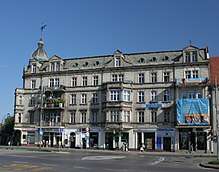
- Franke's House – in the beginning, it belonged to Adolf Franke, a Lutheran hailing from Greater Poland and also an owner of a spinning mill and textile mill. It was being built between 1901 and 1903. Between 1918 and 1939, Hotel 'Victoria' was located there. During World War II, it lay on the border of the Jewish ghetto, which made it the key point for those wanting to escape. After the dismantling of the ghetto, the Franke's House housed German hospital and army hotel, and after the war, it was the seat of the High School of Arts and a bursary. Eclectic with prevailing neo-renaissance features.
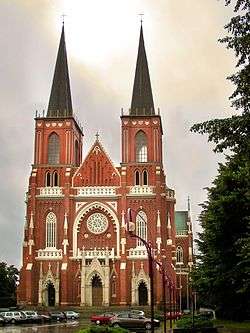
- Zapalkiewicz's House is classicist townhouse, built in 1871. It was the seat of a theatre, which was functioning until 1908. Later, until 1923, there was a cinema "Paryskie" and subsequently, a number of financial institution have had their branches in the building.
- Mercantile Townhouse – eclectic townhouse, was being built between 1894 and 1907. At the beginning business and economics courses were taking place there. Before the World War 2, it was the seat of Warsaw Industrial Bank and Częstochowa Savings and Loans Bank.
- Kohn's House is a neo-classicist townhouse, built in 1865. Before the war, a number of enterprises were operating in the building, including Bankers, Jackowski's Restaurant and Cafe, and Bata's Shoe Shop and between 1909 and 1930 a cinema called "Odeon".
- Polish Bank's Townhouse is an art nouveau townhouse, built in 1904. In the beginning, it was the seat of a local branch of the Russian State Bank. In 1927, the building was taken over by the Polish Bank Inc. After World War II, it became the property of the Polish National Bank. In 1990, the building was sold to the ING Silesian Bank.
- Biegański's House is a one-storey classicist townhouse built in 1880. Initially, it was owned by Karol Henryk Rosenfeld and later by his son-in-law dr. Władysław Biegański. After the Second World War, the building was a seat of the Częstochowa's Doctors Association.
- Hantke's Palace is an example of Baroque Revival architecture, built to the order of an industrialist and entrepreneur Bernard Hantke, who established the ISD Częstochowa Steel Mill. The palace was built between 1900 and 1903. After WW2, the building was the seat of the Częstochowa Steel Mill Culture Centre.
- Former Orthodox Vicarage – classicist townhouse, built in 1875, until 1918 it was the seat of a local Orthodox priest. In 1918, it was taken over by the local Catholic diocese. After the war, there was a local headquarters of the Polish Army. Since the 1970s it has been a property of the Częstochowa Regional Museum.
- Old Square – a square located in the Old Town district with dimensions of 100m by 66m. Since medieval times it operated as the main square of Old Częstochowa. There are still preserved old townhouses, which are listed on the historic monuments register. Between the 15th century and 1812, a town hall was located there, which was then damaged because of a fire. In 2007, archaeological works began. As a result, a city well was found and also fundaments of city facilities such as a weigh house and gallows.
- Wieluńska Street – one of the historic streets in Częstochowa, located in the vicinity of Jasna Góra monastery. It is 300 meters long and the buildings on the street were erected in the late-classicist style in the second half of the 19th century.
- Jasna Góra Parks are two city parks (Stanisław Staszic Park and 3 May Park) located in the city centre, on the slope of Jasna Góra Hill. The parks were established in 1843. The total area of both parks is 11.8 ha. The parks are a popular leisure place and a spot for those enjoying short walks. In 1909, the Great Exhibition of Agriculture and Industry took place in the park, it was attended by 660 exhibitors and 500,000 visitors. In Staszic Park, one can find an astronomical observatory, which was opened in 1909. The parks also accommodate the Iron Ore Museum.
- Ulica 7 Kamienic (7 Townhouses Street) is one of the historical streets in Częstochowa. It is 600 metres long; the street was created in the first half of the 19th century. The name derives from the seven houses which had been built at the beginning.
- Cathedral Basilica of the Holy Family, Częstochowa – a cathedral built in the neo-gothic style between 1901–1927. In 1925, it became a cathedral of a Roman Catholic Diocese of Częstochowa and in 1992 it became the basilica of the Roman Catholic Archdiocese of Częstochowa.
- St James' Church – built between 1869 and 1872 under the initiative of a Tsar's representative for Częstochowa region – Parmen Kashernikov. Initially, it was a seat of an Orthodox parish of Saints Cyril and Methodius. In 1914, it became a property of a Catholic church, serving as an army parish church. After the end of First World War, it was retained by the Catholic church as part of the Recovery of Orthodox Churches in the Second Polish Republic. In 1937, the Archdiocese of Częstochowa established a parish of St James.
- St Sigismund's Church – a gothic church built in the 15th century, making it the oldest parish church in Częstochowa.
- St Barbara's Church – built in the 16th century under the initiative of Father Andrzej Gołdonowski from the Pauline Order. The place is linked to the icon of the Black Madonna of Częstochowa. Following the desecration of the icon by robbers in 1430 who left it at a spring next to the current location of the church.
- The Avenues
- Maryi Panny Avenue
 View on the Avenues
View on the Avenues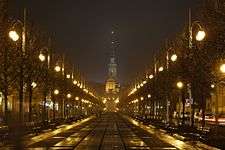 3rd Avenue during the night
3rd Avenue during the night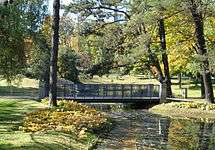 Staszic Park
Staszic Park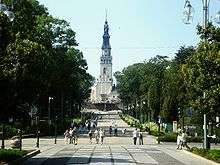 Sienkiewicz Avenue
Sienkiewicz Avenue
Transport
Main road connections from Częstochowa include a connection with Warsaw (to the north-east) and Katowice (to the south) via the European route E75 (Motorway ![]()
![]()
![]()
![]()
The public transport is managed by the Częstochowa City Council of Roads and Transport. The public transport carriage is contracted to the City Public Transport Corporation (Miejskie Przedsiębiorstwo Komunikacyjne).[26] The public transport in Częstochowa comprises 3 tram lines, 30 city bus lines and 8 suburban lines connecting Częstochowa with Blachownia, Mstów, Konopiska, Poczesna, Olsztyn. The bus transport connecting Częstochowa Bus Station with other towns and villages in the Częstochowa region is operated by the Częstochowa Bus Transport Ltd. (PKS Częstochowa).[27]
The closest airport is the Katowice International Airport, which is located 60 km (37 mi) from Częstochowa, and a small Częstochowa - Rudniki airport in Kościelec, Rędziny.
_-_fotopolska.eu_(237734).jpg) Częstochowa, Częstochowa Osobowa (Główna) Railway S tation
Częstochowa, Częstochowa Osobowa (Główna) Railway S tation- Twist tram in Częstochowa
- One of the older trams on Niepodległości (Independence) Avenue
Culture
Museums
In Częstochowa on top of the Jasna Góra Monastery serving the museum and exhibition functions, other similar institutions include:
- Częstochowa Regional Museum, the oldest museum in Częstochowa. The seat of the museum is in the building of a former town hall. The Częstochowa Regional Museum consists of a number of venues in Częstochowa and its surroundings.
- Town Hall, the most presentable Museum building in Częstochowa. It was built in 1828, because of administrative needs arising from the expansion and merger of two towns: Old Częstochowa and New Częstochowa. It has been the seat of Częstochowa Regional Museum since 1967. There is a permanent historical exhibition - 'History of the City of Częstochowa - Stage 1'. It illustrates the development of the city - from its beginnings to the 17th century. The 'Gallery of Prominent Citizens of Częstochowa' reminds about individuals important to the local community. In the gallery 'Attic', occasional temporary exhibitions are presented.[28]
- House of Poetry - Halina Poświatowska Museum, located on Jasnogórska Street 23. After World War 2, Halina Poświatowska and her family lived there. It has been opened since 2006. As a part of the permanent exhibition, the visitors can see documents, memorabilia, photographs and scripts of her poems. Sometimes, in the museum poetry evenings are organised.[29]
- Gallery of 19th and 20th Century Sculpture and Painting, located on Katedralna Street inside a two-storey terrace house from the beginning of the 20th century. There are three exhibitions: Art of Young Poland, Polish Avant-garde and Modern Art, Częstochowa's Art of the 19th century and first half of the 20th century.
- Archaeological Reserve of Lusatian Culture,[30] located in the Raków neighborhood on Łukasińskiego Street. This 2500-year-old burial ground was discovered in 1955 during construction works of Częstochowa's tram line. It is a permanently maintained burial ground from the early stages of the Iron Age (750–550 years BC). Tourists have been able to visit the site since 1965. Around the burial ground, there are showcases about the Lusatian culture.
- Museum of Iron Ore Mining,[31] established in 1976 in underground corridors resembling mine corridors. The Museum recreates mine workings and is equipped with mining equipment from the closed down mine "Szczekaczka".
- Prominent museums
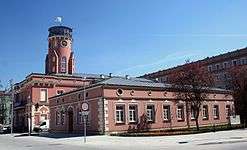 Town Hall and Częstochowa Regional Museum
Town Hall and Częstochowa Regional Museum Halina Poświatowska Museum
Halina Poświatowska Museum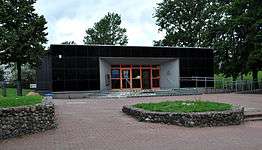 Archaeological Reserve in Częstochowa
Archaeological Reserve in Częstochowa- Iron Ore Mining Museum
 Museum of Match Production
Museum of Match Production
Other museums and galleries
- City Gallery of Art, established in 1977. Promotes and presents modern art. Zdzisław Beksiński The museum forms part of the City Gallery of Art. It also organises cyclical cultural events such as IV Triennale of Art 'Sacrum', Jurajska Autumn, City Setting.[32]
- Museum of Match Production (pl), located inside the building of a former match factory on Ogrodowa Street. The visitors can see the historic machine park from the late 19th century and retrace the match-making process - from barking through making 'sticks' to packing the matches. In the museum, there are also documents relating to the match-making industry and an exhibition called 'Sculptures from a single match'. In another hall, one can see a phillumenist exhibition, where matchbox labels from various periods are displayed.[33]
- Museum of Railway History, where souvenirs, railway equipment and railway elements are gathered. The museum is located on the first floor of Częstochowa Stradom railway station. It was established in 2001. Two historical steam engines are under the care of the museum.
- Museum of the Roman Catholic Archdiocese of Częstochowa. The museum is located in the building of the Theological College of Roman Catholic Archdiocese of Częstochowa on Św. Barbary Street. It was established in 1997. Among exhibits are sculptures (including Mary the Virgin's sculpture from 1430, sculpture of St Martin from 1500) and pictures showing scenes from the life of Jesus Christ and Mary the Mother of God and saints. Additionally, there are commemoration numismatics and medals.
- Tomasz Sętowski's Museum of Imagination[34]
- Museum of Coins and Medals commemorating John Paul II[35]
- Gallery 'Konduktorownia'[36]
Music
The Bronisław Huberman Philharmonic of Częstochowa is located in the city centre on Wilson Street, in the building erected between 1955 and 1965 on foundations of New Synagogue, which had been burnt down on 25 December 1939. The Philharmonic has at its disposal two concert halls and one rehearsal hall. The large concert hall can accommodate 825 people, whilst the small hall has 156 seats.
The concert hall of the Philharmonic of Częstochowa is a place where concerts of symphonic orchestra take place. The building itself is younger than the history of symphonic concerts in Częstochowa, as the first concert took place in March 1945. The mixed choir has been functioning since the Philharmonic was set up. The choir was professionalized in September 2012 and it was named The Częstochowa Philharmonic Choir "Collegium Cantorum".[37]
The Philharmonic is also a co-organiser and a co-performer of operas, operettas and ballets. It is also a place where various exhibitions take place. The Philharmonic annually organises Bronisław Huberman International Violin Festival, Reszek Vocal Competition, Festival of Traditional Jazz "Hot Jazz Spring". The Philharmonic also engages in organising the "Night of Culture", the International Festival of Sacral Music "Gaude Mater" and the Bach Family Music Festival.
Music education is also an important part of the Philharmonic's activity. Its educational functions are carried out through a series of concerts such as "Music for children", "FEEL harmony - feel the climate!" and "Sunday Mornings with Philharmonic". In 2010, the building of The Philharmonic of Cżęstochowa was refurbished through the financial support from the European Fund of Regional Development.[38]
In Częstochowa, there are many functioning female, male and mixed choirs. The oldest is the Male Choir "Pochodnia" (Torch). Others include the Academic Choir of the Częstochowa University of Technology, the Jasna Góra Vocal Ensemble "Camerata" and the Archcathedral Choir of the Holy Family "Basilica Cantans".
Theatre
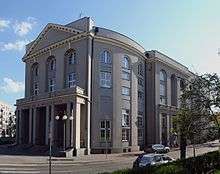
Adam Mickiewicz Theatre is located on Kiliński Street in the city centre. The building was erected between 1928 and 1931. Between 1979 and 1984 it was refurbished. The theatre has three halls: Big, Small, Histrion and Marek Perepeczko Foyer. The Theatre organises "Festival of Important Plays - Through Touch", "Festival of High School Theatres" and "Children's Land of Sensitivity". It also takes part in annually organised "Night of Culture".[39]
Festivals
The Centre for the Promotion of Culture 'Gaude Mater' is a cultural institution established in 1991. It is the organiser of various cultural events in Częstochowa, such as:
- International Festival of Sacral Music 'Gaude Mater'. It has been organised since 1991 and it takes place each year at the beginning of May. It is organised under the auspices of The Ministry of Culture and National Heritage and the Polish Episcopal Conference. The main aim of the festival is to bring various cultures closer through presenting music typical of different religions. It also seeks to present contemporary Polish music and to promote young composers through "Musica Sacra" - The International Competition for Young Composers. The Gaude Mater festival also addresses problematic aspects of the sacrum in music during various seminars organised during the Festival.[40]
- The Night of Culture, the annual cultural event organised in Częstochowa. For a single fare, one can attend plays, performances, concerts and exhibitions specially prepared for that night.
- Days of Cżęstochowa
- Days of European Folk Culture
- Days of Christian Culture
- Low-key Jazz
- Kalina Jędrusik Festival
- Worldwide Congress of Częstochowians
- The Częstochowa Song and Dance Ensemble operating under the auspices of Gaude Mater
Music festivals
- The International Festival of Sacral Music "Gaude Mater"[41]
- The International Festival of Traditional Jazz "Hot Jazz Spring Częstochowa"[42]
- Częstochowa Festival of Alternative Culture "Frytka-OFF"[43]
- ReaggeON Częstochowa[44]
- HipHop Elements[45]
- Aleje tu się dzieje (Avenues - Something's going on here)[46]
Cinemas
In Częstochowa, there are three cinemas. Two are part of chain of cinemas Cinema City Poland: Cinema City "Wolność" (Freedom), which has 1766 seats, and Cinema City Galeria Jurajska, opened in 2009.[47] There is also an independent cinema, Ośrodek Kultury Filmowej (Centre of Cinematography[48]), established in 1991.
Healthcare
- Public hospitals
 Regional Specialist Hospital - Parkitka, Nowobialska Street
Regional Specialist Hospital - Parkitka, Nowobialska Street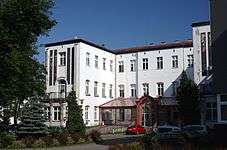 City Polyclinical Hospital - Mirowska Street
City Polyclinical Hospital - Mirowska Street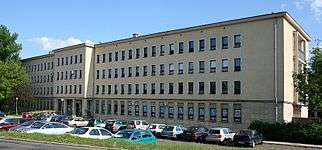 Regional Specialist Hospital - PCK Street
Regional Specialist Hospital - PCK Street- City Polyclinical Hospital - Mickiewicz Street
- Regional Specialist Hospital (Nowobialska Street and PCK Street)
- City Polyclinical Hospital (Bona Street, Mickiewicz Street and Mirowska Street)
- Weigel Hospital in Blachownia
- Metallurgic Hospital in Częstochowa
Education
Some of the tertiary educational institutions in Częstochowa include:
- Częstochowa University of Technology[49]
- Jan Długosz University (previously Wyższa Szkoła Pedagogiczna)[50]
- Polonia University (previously Wyższa Szkoła Języków Obcych i Ekonomii)[51]
- Wyższa Szkoła Hotelarstwa i Turystyki (School of Graduate Studies in Hospitality Management and Tourism)[52]
- Wyższa Szkoła Lingwistyczna (College of Foreign Language Studies)[53]
- Wyższa Szkoła Zarządzania (College of Management)[54]
- Centrum Języków Europejskich - Nauczycielskie Kolegium Języków Obcych ( Center of European Languages - Teacher's College of Foreign Languages)[55]
- Wyższe Seminarium Duchowne Archidiecezji Częstochowskiej (Theological College of Roman Catholic Archdiocese of Częstochowa)[56]
- Centralna Szkoła Państwowej Straży Pożarnej w Częstochowie (The Central School of the State Fire Services in Częstochowa)[57]
Sports
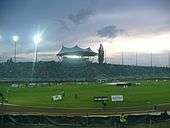
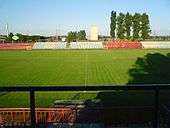

The most popular sports in Częstochowa are speedway, volleyball and football. The following teams represent Częstochowa on a national level:
Speedway
- CKM Włókniarz Częstochowa – speedway team from Częstochowa, established in 1946 3rd place in season 2005, 2nd place in season 2006 first place in season 2003, 3rd place in 2009. Włókniarz finished last season in 1 Liga (2nd Tier) on 3rd place and obtained promotion to Speedway Ekstraliga.[58]
Volleyball
- AZS Częstochowa – men's volleyball team playing in Krispol 1. Liga Siatkarzy (Polish 2nd Division), 6 times Polish champion, 6 times 2nd place in Polish championship, 4 times 3rd place in Polish championship, twice Polish Cup winner, winner of the CEV Challenge Cup 2011/2012, 16th place and relegation from PlusLiga in season 2016/2017. The club was established in 1945.
- KS Norwid Częstochowa – men's volleyball team playing in Krispol 1. Liga Siatkarzy (2nd level in the Polish volleyball league system). The club was established in 2002.
- KS AJD Częstochowianka Częstochowa – women's volleyball team playing in PZPS Druga Liga Kobiet (3rd level in the Polish volleyball league system).
Football
- Raków Częstochowa – Częstochowa's greatest football team, plays in the I liga (Poland) (2nd level of the Polish football league system). Runners-up of the Polish cup in 1966–67. As youngsters, both Jerzy Brzęczek and Jakub Błaszczykowski played for Raków, as well as Jacek Krzynówek. The club was established in 1921. They finished season 2016/2017 in II liga (3rd level in the Polish football league system) on 1st place and obtained promotion to I liga (Poland).
- Skra Częstochowa – Częstochowa's second-best football team, plays in the III Liga Opole-Silesia Division (4th level of the Polish football league system). The club was established in 1926. They finished season 2015/2016 on 7th place.
- Victoria Częstochowa – team playing in Liga Okręgowa – Częstochowa Regional Division (6th level of the Polish football league system). The club was established in 1922.
- KS Stradom Częstochowa – team playing in Liga Okręgowa – Częstochowa Regional Division (6th level of the Polish football league system). The club was established in 1934.
- LKS Płomień Kuźnica Marianowa – team playing in Liga Okręgowa – Częstochowa Regional Division (6th level of the Polish football league system). The club was established in 1982.
- Orzeł Kiedrzyn – team playing in Liga Okręgowa – Częstochowa Regional Division (6th level of the Polish football league system). The club was established in 1950.
- UKS Ajaks Częstochowa – team playing in Klasa B – Częstochowa Regional Division (8th level of the Polish football league system). The club was established in 1998.
- Gol Częstochowa – women's football team playing in I Liga Kobiet (2nd level of the Polish female football league system). The club was on 6th place in season 2014/15.
Other teams
- KU AZS Częstochowa – Częstochowa's basketball team, plays in Druga Liga PzKosz (4th level of the Polish basketball league system)
- Rugby Club Częstochowa – Częstochowa's rugby team, plays in Polish 3rd League rugby XV and in 7's League, established in 2005
- Saints Częstochowa – American Football team playing in PLFA II. The club was established in 2010.
- Defenders Częstochowa – Baseball team playing in Polish Baseball 2nd League. The club was established in 2013.
- Table Tennis – AJD Print Cycero Rolnik AZS Częstochowa, AZS AJD Mustang Częstochowa
- Tennis – CzKT Victoria
- Badminton – Kolejarz Częstochowa
- Chess – Hetman Częstochowa
- Weightlifting – KS Polonia Częstochowa
- Velodrome team – Lwy Częstochowa
Sport venues
- Arena Częstochowa – multifunctional stadium located in Zawodzie district. It is mostly used by the speedway club Włókniarz Częstochowa. The stadium was built in 1946. Following the modernisation, it can accommodate 16,850 spectators.
- Sports Hall Częstochowa – multifunctional sports hall located in Zawodzie district. It can accommodate 7,100 spectators. It meets all the criteria as set out by the FIVB and FIBA. It was officially opened on 29 September 2012. The hall has hosted various events including volley league matches of AZS Częstochowa, boxing fights and concerts.
- Polonia Hall – multifunctional sports hall in Tysiąclecie district. The hall was officially opened in 1985. It is administered by the City Council Centre of Sport and Leisure. The hall is mostly used by volleyball and basketball teams. It can accommodate 3,015 spectators.[59]
- City Football Stadium "Raków" – a football stadium located in Raków district. It is mostly used by Raków Częstochowa and Gol Częstochowa. The stadium was officially opened in 1955. Currently, it can accommodate up to 8,000 spectators. The stadium has 3,720 seats. There are further plans for modernisation, which include increasing the number of seats to 10,100.
- City Athletics Stadium – a stadium administered by the City Council Centre of Sport and Leisure. The stadium was built in 1965, but extensively modernised in 2000. The stadium has 894 seats.[60]
- Rosa Private Golf Club – located in Konopiska, 17 km (11 mi) from Częstochowa[61]
- Three indoor swimming pools and one outdoor swimming pool
Administration
Częstochowa is a city with powiat rights. Residents of Częstochowa elect 28 city councillors. The executive branch of local government is a city mayor. The city hall is located in Śląska Street 11/13.
The city is divided into 20 neighborhoods. The residents of each neighborhood elect Neighborhood Council members.
The neighborhoods of Częstochowa include: Błeszno, Częstochówka-Parkitka, Dźbów, Gnaszyn-Kawodrza, Grabówka, Kiedrzyn, Lisiniec, Mirów, Ostatni Grosz, Podjasnogórska, Północ, Raków, Stare Miasto, Stradom, Śródmieście, Trzech Wieszczów, Tysiąclecie, Wrzosowiak, Wyczerpy-Aniołów, and Zawodzie-Dąbie.
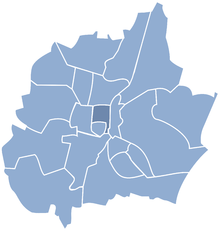
Politics
Local government
The current Mayor of Częstochowa is Krzysztof Matyjaszczyk, a member of Democratic Left Alliance.
In the Częstochowa 2018 mayoral elections the results were as follows:[62] Krzysztof Matyjaszczyk (Democratic Left Alliance) 59.76%, Artur Warzocha (Law and Justice) 25.54%, Marcin Maranda (Residents of Częstochowa) 6.17%, Tomasz Jaskóła (Kukiz'15) 5.27%, Jacek Krawczyk (Civic Coalition) 2.83%, Martin Saczek (Razem) 0.43%.
In the Częstochowa City Council Elections 2018 the results were as follows.[63] Seats in the city council: Left Democratic Alliance (32.80%) 12, Law and Justice (26.04%) 10, Civic Coalition (15.98%) 5, Together for Częstochowa (Independents) (8.77%) 1. After elections in Częstochowa was formed a centre-left coalition between liberal and pro-market Civic Coalition and social democratic Left Democratic Alliance. Conservative Law and Justice remained in opposition.[64]
Electoral districts[65]
| District | Seats |
|---|---|
| 1. District (central):
Podjasnogórska, Stare Miasto, Śródmieście, Trzech Wieszczów |
|
| 2. District (northwestern):
Częstochówka-Parkitka, Kiedrzyn, Tysiąclecie |
|
| 3. District (northeastern):
Mirów, Północ, Wyczerpy-Aniołów, Zawodzie-Dąbie |
|
| 4. District (southeastern):
Ostatni Grosz, Raków, Wrzosowiak |
|
| 5. District (southwestern):
Błeszno, Dźbów, Gnaszyn-Kawodrza, Grabówka, Lisiniec, Stradom |
Częstochowa constituency
| lower house of Parliament (Sejm) | higher house of Parliament (Senate) | Silesian Regional Assembly |
|---|---|---|
| Szymon Giżyński (PiS), Mariusz Trepka (PiS),
Lidia Burzyńska (PiS), Andrzej Gawron (PiS), |
Wojciech Konieczny (SLD), | Marta Salwierak (KO),
Gabriela Łacna (SLD), Beata Kocik (PiS), Piotr Bańka (PiS) |
Media
- Daily newspapers
- Gazeta Wyborcza – since 1991 it has been published with a local supplement
- Dziennik Zachodni – published with local supplement
- Życie Częstochowy i Powiatu (Life of Częstochowa and Region) – it has been published since 1947
- Weeklies
- Gazeta Częstochowska (Częstochowa's newspaper) – since 1956
- Częstochowski Tygodnik Regionalny – 7 dni (Częstochowa's Regional Weekly – 7 days) – since 2004
- Niedziela (Sunday) – nationwide Catholic weekly newspaper that has been published since 1926
- Poniedziałek (Monday)
- Tydzień w Czestochowie.pl
There are also published cultural quarterlies such as: Aleje 3, Bulion; a monthly Puls Regionu and an annual – Ziemia Częstochowska
- Radio and TV
- Radio Jasna Góra – Catholic radio station broadcast from the Jasna Góra Monastery
- Radio Fiat – Catholic radio station belonging to the Roman Catholic Archdiocese of Częstochowa
- Radio Jura – local radio station
- Polskie Radio Katowice
- Radio Złote Przeboje
- RMF Classic
- RMF Maxxx
- TV Orion
Religion and places of worship
- Prominent churches
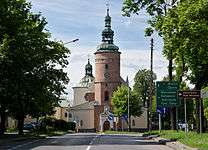 St Barbara and St Andrew Church
St Barbara and St Andrew Church St Sigismund Church
St Sigismund Church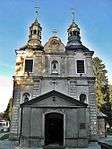 St Roch and Sebastian Church
St Roch and Sebastian Church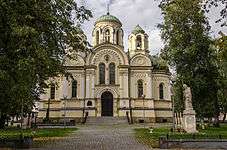 St Jacob's Church
St Jacob's Church Katedra Polskokatolicka
Katedra Polskokatolicka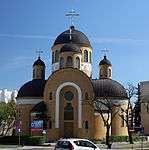 Cerkiew Ikony
Cerkiew Ikony
In addition to the Roman Catholic Church and Polish Orthodox Church, various denominations are present in Częstochowa, including Evangelical Church of the Augsburg Confession in Poland, Baptist Union of Poland, Jehovah Witnesses, Pentecostal Church, Plymouth Brethren, Seventh-day Adventist Church, and Polish Catholic Church. Częstochowa is the Seat of the Roman Catholic Archdiocese of Częstochowa, as well as Holy Family Archdiocese Cathedral in Częstochowa, and the Jasna Góra Monastery along with 50 Catholic Parish Churches.[66]
Notable people
- Pinchas Menachem Justman (1848–1920), Jewish Hasidic Rabbi
- Władysław Biegański (1857–1917), medical doctor, philosopher and social activist
- Bronisław Huberman (1882–1947), Polish-Jewish classical violinist and founder of the Palestine Philharmonic Orchestra, now Israel Philharmonic Orchestra
- Alexander Imich (1903–2014), Polish-American chemist
- Samuel Willenberg (1923–2016), Polish-Jewish Treblinka survivor who participated in the uprising
- Hershl Sperling (1927–1989), participant in the Treblinka revolt and escapee[67]
- Kalina Jędrusik (1930–1991), singer and actress
- Janusz Kochanowski (1940-2010), lawyer, Polish Ombudsman for Citizen's Rights
- Marion Kozak (born 1934), Polish-born British activist, mother of British politicians David Miliband and Ed Miliband
- Halina Poświatowska (1935–1967), poet and writer
- Ingrid Pitt (1937–2010), Polish-British actress, author, and writer
- Jerzy Kulej (1940–2012), boxer and politician
- Jerzy Duda-Gracz (1941–2004), painter
- Adam Szostkiewicz (born 1952), author and political commentator
- Janusz Iwański (born 1956), jazz and rock guitarist, composer, songwriter and vocalist
- Zygmunt Staszczyk (born 1963), singer
- Agnes Milowka (1981–2011), Australian technical diver, underwater photographer, author, maritime archaeologist and cave explorer
- Jakub Błaszczykowski (born 1985), footballer
- Julia Banaś (born 1997), model
Twin towns – sister cities
Częstochowa is twinned with:[68]
References
- "Local Data Bank". Statistics Poland. Retrieved 22 June 2020. Data for territorial unit 2464000.
- "Częstochowa". Lexico UK Dictionary. Oxford University Press. Retrieved 3 August 2019.
- "Czestochowa". Merriam-Webster Dictionary. Retrieved 3 August 2019.
- "Częstochowa Official Website". Urząd Miasta Częstochowy, ul. Śląska 11/13, 42-217 Częstochowa. Retrieved September 15, 2014.
- "Częstoch" w Słowniku geograficznym Królestwa Polskiego i innych krajów słowiańskich, Tom I (Aa – Dereneczna) z 1880 (in Polish)
- Franciszek Kulczycki, "Monumenta mediiaevi historica res gestas Poloniae illustrantia", Tomus IX, Cracoviae, 1886, p. 27.
- Joshua D. Zimmerman, Poles, Jews, and the Politics of Nationality, Univ of Wisconsin Press, 2004, ISBN 0-299-19464-7, Google Print, p.16
- Theodore R. Weeks, "Polish-Jewish relations 1903-1914: The view from the chancellery," Canadian Slavonic Papers, Sep-Dec 1998
- "Anti-Semitic outbreak," New York Times, September 14, 1902
- "Czestochowa, Poland (Pages 39–47)". www.jewishgen.org. Retrieved 15 March 2018.
- "Holocaust Survivors: Encyclopedia - "Czestochowa Ghetto"". www.holocaustsurvivors.org. Archived from the original on 2 July 2017. Retrieved 15 March 2018.
- Duricy, Michael P. "Black Madonnas: Our Lady of Częstochowa". © 2008 The Marian Library/International Marian Research Institute, Dayton, Ohio. Archived from the original on 2011-10-12. Retrieved 2008-10-22.
- "Klimat: Częstochowa: Klimatogram, wykres temperatury, tabela klimatu - Climate-Data.org". pl.climate-data.org. Retrieved 2019-01-04.
- Update of the Environmental Protection Program for the city of Częstochowa (Poland). City Hall of Czestochowa. [access 2011-04-06]. archived from this address (2012-02-05).
- "Częstochowa (12550) - WMO Weather Station". NOAA. Retrieved January 4, 2019. Archived January 4, 2019, at the Wayback Machine.
- "Regionalna Izba Przemysłowo-Handlowa w Częstochowie". www.riph.czest.pl. Retrieved 15 March 2018.
- "Home". isd-poland.com. Archived from the original on 21 October 2015. Retrieved 15 March 2018.
- "We've moved!". www.trw.com. Retrieved 15 March 2018.
- "Cooper Standard". Cooper Standard. Retrieved 15 March 2018.
- "Home page". Brembo – Official WebSite. Retrieved 15 March 2018.
- "Wystąpił błąd..." www.koksownianowa.pl. Archived from the original on 2017-06-22. Retrieved 15 March 2018.
- http://www.strony.com.pl/, Kaczka Studio -. "Guardian Częstochowa". guardian-czestochowa.com. Retrieved 15 March 2018.
- "Archived copy". Archived from the original on 2015-11-01. Retrieved 2015-10-19.CS1 maint: archived copy as title (link)
- "Wyborcza.pl". czestochowa.gazeta.pl. Retrieved 15 March 2018.
- "Wyborcza.pl".
- "MPK in Częstochowie Sp. z o. o. - Home". www.mpk.czest.pl. Retrieved 15 March 2018.
- "PKS Częstochowa". PKS Częstochowa. Archived from the original on 31 August 2015. Retrieved 15 March 2018.
- "Muzeum Częstochowskie". Muzeumczestochowa.pl. Retrieved 2014-07-31.
- "Dom Poezji - Muzeum Haliny Poświatowskiej". Poswiatowska.muzeumczestochowa.pl. Retrieved 2014-07-31.
- "Rezerwat ArcheologicznyDotknij przeszłości…Zapraszamy nauczycieli wraz z uczniami na warsztaty! - Muzeum Częstochowskie". www.muzeumczestochowa.pl. Retrieved 15 March 2018.
- "Muzeum Górnictwa Rud Żelaza - Muzeum Górnictwa Rud Żelaza – Muzeum Częstochowskie". kopalnia.muzeumczestochowa.pl. Retrieved 15 March 2018.
- www.trustnet.pl. "Miejska Galeria Sztuki w Częstochowie". www.galeria.czest.pl. Retrieved 15 March 2018.
- imoli.pl. "Częstochowskie Muzeum Zapałek". www.zapalki.pl. Retrieved 15 March 2018.
- "Tomek Sętowski - Fabryka Snów - Muzeum". Setowski.art.pl. Archived from the original on 2014-08-16. Retrieved 2014-07-31.
- "Museum of Coins and Medals Commemorating John Paul II". Jp2muzeum.pl. Retrieved 2014-07-31.
- "Konduktorownia". Konduktorownia.eu. Retrieved 2014-07-31.
- "Collegium Cantorum Excellence comes from experience". Collegiumcantorum.com. Archived from the original on 2014-08-08. Retrieved 2014-07-31.
- 2013, Kaczka Studio, www.kaczka.com ®. "Bronislaw Huberman Czestochowa Philharmonic Hall". www.filharmonia.com.pl. Retrieved 15 March 2018.CS1 maint: numeric names: authors list (link)
- Redhand.pl - Strony Internetowe Częstochowa. "Teatr im. Adama Mickiewicza w Częstochowie". Teatr-mickiewicza.pl. Retrieved 2014-07-31.
- "Festiwal Muzyki Sakralnej Gaude Mater 2014 :: Glowna :: Międzynarodowy Festiwal Muzyki Sakralnej w Częstochowie" (in Polish). Gaudemater.com. Retrieved 2014-07-31.
- "Gaudemater" (in Polish). Gaudemater.pl. Archived from the original on 2014-07-26. Retrieved 2014-07-31.
- Szymon Mrożek (2011-03-22). "X Międzynarodowy Festiwal Jazzu Tradycyjnego Hot Jazz Spring". Hotjazzspring.eu. Retrieved 2014-07-31.
- "Częstochowski Festiwal Kultury Alternatywnej FRYTKA OFF ::: 21-22 czerwca 2013". Frytkaoff.czestochowa.pl. 2013-01-24. Retrieved 2014-07-31.
- "ReggaeOn - Częstochowa". Reggaeon.czestochowa.pl. 2013-01-24. Archived from the original on 2015-04-04. Retrieved 2014-07-31.
- "HIP HOP Elements Częstochowa". pl-pl.facebook.com. Retrieved 15 March 2018.
- Bielecka, Katarzyna (2013-01-24). "Aleje - tu się dzieje". Aleje.czestochowa.pl. Retrieved 2014-07-31.
- "Premiery filmowe - Zapowiedzi - Filmy 3D - Cinema City - Strona główna". www.cinema-city.pl. Retrieved 15 March 2018.
- "Ośrodek Kultury Filmowej w Częstochowie". Okf.czest.pl. Retrieved 2014-07-31.
- "Politechnika Częstochowska - 67 lat doświadczenia w działalności naukowej i edukacyjnej". www.pcz.pl. Retrieved 15 March 2018.
- Akademia Jana Długosza (previously Wyższa Szkoła Pedagogiczna)
- "Akademia Polonijna - Polonia University - studia ekonomia, pielęgniarstwo licencjat pielęgniarstwo magister, studia pomostowe praca socjalna filologia angielska prawo w biznesie studia podyplomowe, kryminalistyka, ekspertyza dokumentów, przygotowanie pedagogiczne". www.ap.edu.pl. Retrieved 15 March 2018.
- "School of Graduate Studies in Hospitality Management and Tourism in Częstochowa". Wshit.edu.pl. Retrieved 2013-12-23.
- "Studiuj Online - Wyższa Szkoła Lingwistyczna w Częstochowie". www.wsl.edu.pl. Retrieved 15 March 2018.
- "Dla kandydatów" (in Polish). Wsz.edu.pl. Retrieved 2013-12-23.
- "CJE-NKJO Częstochowa - News" (in Polish). Cjenkjo.edu.pl. Archived from the original on 2013-12-13. Retrieved 2013-12-23.
- "Wyższe Seminarium Duchowne Archidiecezji Częstochowskiej" (in Polish). Seminarium.czest.pl. Retrieved 2013-12-23.
- imoli.pl. "Strona główna - Centralna Szkoła Państwowej Straży Pożarnej w Częstochowie" (in Polish). Cspsp.pl. Retrieved 2013-12-23.
- Włókniarz Częstochowa (2013). Najlepsze biegi sezonu [The best games of the season] (Sports TV broadcast). Częstochowa: Speedway Włókniarz Częstochowa.
- Plus, Internet. "Miejski Ośrodek Sportu i Rekreacji w Częstochowie". www.mosir.pl. Retrieved 15 March 2018.
- Plus, Internet. "Miejski Ośrodek Sportu i Rekreacji w Częstochowie". www.mosir.pl. Retrieved 15 March 2018.
- http://rpgc.pl
- "Wybory samorządowe 2018". wybory2018.pkw.gov.pl. Retrieved 2018-12-27.
- "Wybory samorządowe 2018". wybory2018.pkw.gov.pl. Retrieved 2018-12-27.
- "Wyborcza.pl". czestochowa.wyborcza.pl. Retrieved 2018-12-27.
- "Częstochowa: Wybory Samorządowe 2018 | Wyniki, kandydaci, okręgi, sondaże". www.portalsamorzadowy.pl (in Polish). Retrieved 2018-12-27.
- "Kuria Metropolitalna w Częstochowie | Parafie alfabetycznie" (in Polish). Kuriaczestochowa.pl. Archived from the original on 2013-12-16. Retrieved 2013-12-23.
- "Hershl Sperling testimony on the Treblinka Death Camp". Holocaust Research Project. Archived from the original on 2012-12-20.
- "Miasta partnerskie". czestochowa.pl (in Polish). Częstochowa. Retrieved 2020-03-10.
Further reading
- Duricy, Michael P. "Black Madonnas: Our Lady of Częstochowa". University of Dayton. Archived from the original on 2011-10-12. Retrieved 2018-03-18.
- "Sanktuarium Matki Bożej Częstochowskiej na Jasnej Górze" (in Polish). Jasna Góra. Retrieved 2018-03-18.
- "Częstochowa Official Website". City of Czestochowa. Retrieved 2018-03-18.
External links
| Wikimedia Commons has media related to Częstochowa. |
| Wikisource has the text of the 1905 New International Encyclopedia article Czenstochowa. |
- Official website
- The Black Madonna Monastery
- Częstochowa Yizkor Book – remembering Częstochowa Jews murdered by Nazis
- 8 Częstochowa Yizkor Books at NYPL
- Częstochowa, Poland at JewishGen

